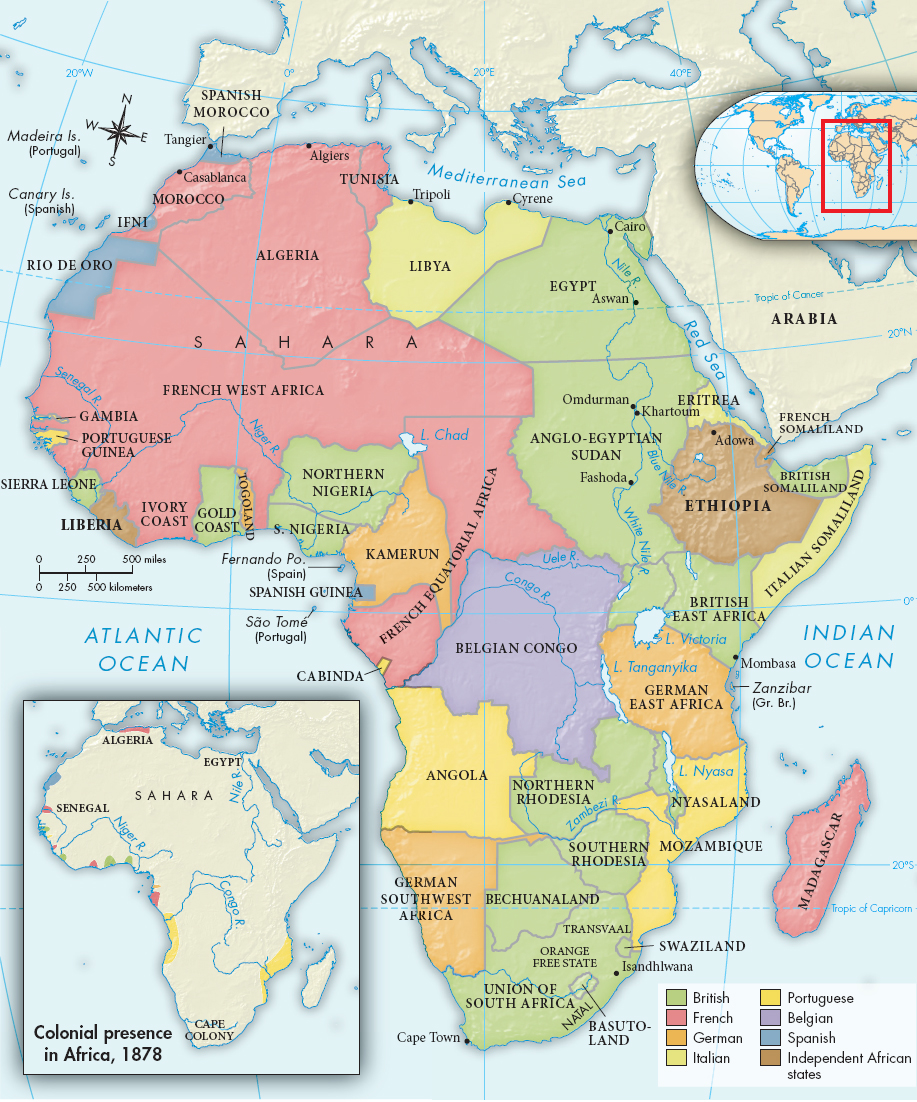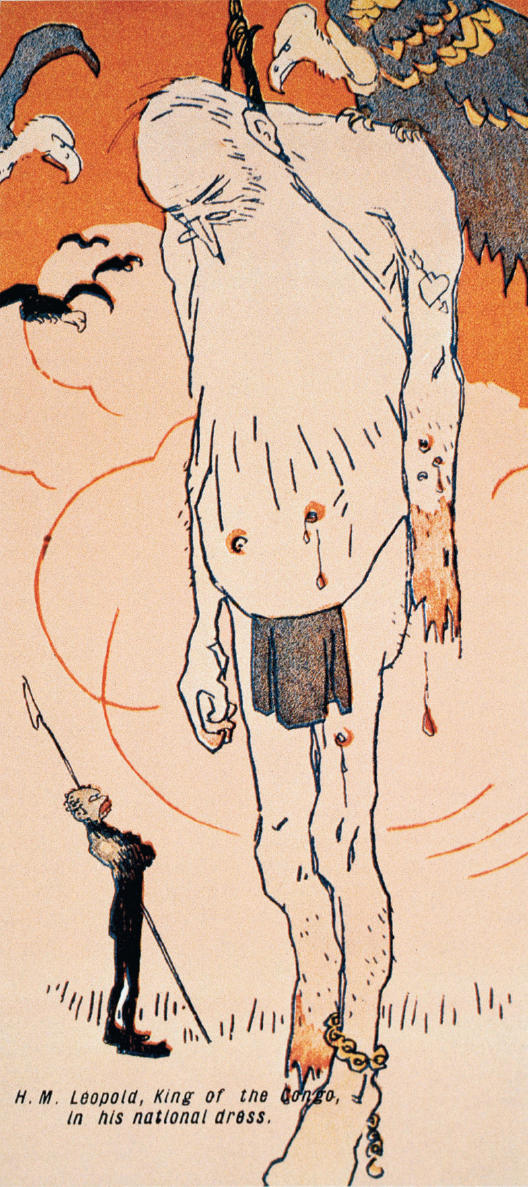The Scramble for Africa After 1880
Between 1880 and 1900, Britain, France, Belgium, Germany, and Italy scrambled for African possessions (Map 24.2). By 1900, nearly the whole continent had been carved up and placed under European rule: only Ethiopia, which fought off Italian invaders, and Liberia, which had been settled by freed slaves from the United States, remained independent.
The Dutch-settler republics also succumbed to imperialism, but the final outcome was different. The British, led by Cecil Rhodes (1853–1902) in the Cape Colony, leapfrogged over the two Afrikaner states — the Orange Free State and the Transvaal — in the early 1890s and established protectorates over Bechuanaland (bech-WAH-nuh-land; now Botswana) and Rhodesia (now Zimbabwe and Zambia). English-speaking capitalists like Rhodes developed fabulously rich gold mines in the Transvaal, and the British eventually conquered their white rivals in the bloody South African War, or Boer War (1899–1902). In 1910, the Afrikaner territories were united with the old Cape Colony and the eastern province of Natal in a new Union of South Africa, established as a largely “self-governing” colony. Gradually, though, the defeated Afrikaners used their numerical superiority over the British settlers to take political power, as even the most educated nonwhites lost the right to vote, except in the Cape Colony. (See “Individuals in Society: Cecil Rhodes.”)
In the complex story of the European seizure of Africa, certain events and individuals stand out. Of enormous importance was the British occupation of Egypt in 1882, which established the new model of formal political control (see page 747). King Leopold II of Belgium (r. 1865–1909), an energetic, strong-willed monarch of a tiny country with a lust for distant territory, also played an important role.

MAP 24.2 The Partition of AfricaThe European powers carved up Africa after 1880 and built vast political empires. European states also seized territory in Asia in the nineteenth century, although some Asian states and peoples managed to maintain their political independence. Compare the patterns of European imperialism in Africa and Asia, using this map and Map 24.3.> MAPPING THE PASTANALYZING THE MAP: What European countries were leading imperialist states in both Africa and Asia, and what lands did they hold? What countries in Africa and Asia maintained their independence? What did the United States and Japan have in common in Africa and Asia?CONNECTIONS: The late nineteenth century was the high point of European imperialism. What were the motives behind the rush for land and empire in Africa and Asia?

European Imperialism at Its WorstThis 1908 English cartoon, “Leopold, King of the Congo, in his national dress,” focuses on the barbaric practice of cutting off the hands and feet of Africans who refused to gather as much rubber as Leopold’s company demanded. In 1908, an international human rights campaign forced the Belgian king to cede his personal fief to the Belgian state. (The Granger Collection, New York)
By 1876, Leopold’s expansionism focused on central Africa. He formed a financial syndicate under his personal control to send Henry M. Stanley to the Congo basin. Stanley established trading stations, signed unfair treaties with African chiefs, and planted the Belgian flag. Leopold’s actions alarmed the French, who quickly took steps to establish a French protectorate on the north bank of the Congo River.
Leopold’s intrusion into the Congo area called attention to the possibilities of African colonization, and by 1882, Europe had caught “African fever.” To lay down some basic rules for this new and dangerous global competition, Jules Ferry of France and Otto von Bismarck of Germany arranged an international conference on Africa in Berlin in 1884 and 1885. The Berlin Conference established the principle that European claims to African territory had to rest on “effective occupation” (a strong presence on the ground) to be recognized by other states. The conference recognized Leopold’s personal rule over a neutral Congo Free State and agreed to work to stop slavery and the slave trade in Africa.
The Berlin Conference coincided with Germany’s sudden emergence as an imperial power. Prior to about 1880, Bismarck, like many other European leaders at the time, had seen little value in colonies. In 1884 and 1885, as political agitation for expansion increased, Bismarck did an abrupt about-face, and Germany established protectorates over a number of small African kingdoms and tribes. In acquiring colonies, Bismarck cooperated against the British with France’s Jules Ferry, an ardent republican who also embraced imperialism. With Bismarck’s tacit approval, the French took control of parts of West and Central Africa.
Meanwhile, the British began enlarging their own West African enclaves and impatiently pushed northward from the Cape Colony and westward from Zanzibar. Their thrust southward from Egypt was blocked in Sudan by fiercely independent Muslims who massacred a British force at Khartoum in 1885.
A decade later, another British force, under General Horatio H. Kitchener, moved cautiously and more successfully up the Nile River, building a railroad to supply arms and reinforcements as it went. Finally, in 1898, these British troops met their foe at Omdurman (ahm-duhr-MAHN), where Sudanese Muslim troops charged time and time again, only to be cut down by the recently invented Maxim machine gun. In the end, about 10,000 Muslim soldiers lay dead, while only 28 Britons had been killed and 145 wounded.2
Continuing up the Nile after the Battle of Omdurman, Kitchener’s armies found that a small French force had already occupied the village of Fashoda (fuh-SHOH-duh). The result was a serious diplomatic crisis and the threat of war between two Great Powers. Wracked by the Dreyfus affair (see "Republican France" in Chapter 23) and unwilling to fight, France eventually backed down and withdrew its forces, allowing the British to take over.

